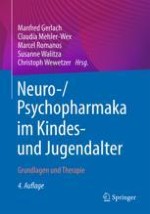Zusammenfassung
In der spezifischen Behandlung der Aufmerksamkeitsdefizit‑/Hyperaktivitätsstörung (ADHS) findet die medikamentöse Therapie häufige Anwendung und zeigt eine sehr gute Wirksamkeit, Tolerabilität und Sicherheit. Dabei stehen im Kindes- und Jugendalter Psychostimulanzien (Methylphenidat und Amphetamin) in verschiedenen Applikationsformen als Medikation der ersten Wahl zur Verfügung. Nicht-Psychostimulanzien wie Atomoxetin und Guanfacin sind weitere Optionen in der medikamentösen Behandlung. Langwirksame Formulierungen von Psychostimulanzien bieten häufig Vorteile hinsichtlich Wirkung und Medikamentenadhärenz. Entscheidend für die Indikation zur Medikation einer ADHS sind die individuelle psychosoziale Beeinträchtigung, das Alter der Patienten und der Schweregrad der Störung. In der Wahl des geeigneten Medikamentes sind, eingebettet in ein multimodales Behandlungskonzept, individuelle Gegebenheiten wie Komorbiditäten zu berücksichtigen. Unter der Behandlung sind regelmäßige Kontrollen z. B. von Gewichtsentwicklung, Puls und Blutdruck zur Erfassung eventueller unerwünschter Arzneimittelwirkungen sowie Auslassversuche durchzuführen. Das folgende Kapitel gibt neben der Störungsdefinition einen Überblick über diagnostische Voraussetzungen, die individuelle Indikationsstellung und die Anwendung der Psychopharmakotherapie in der Behandlung der ADHS und einiger häufiger komorbider Störungen.











